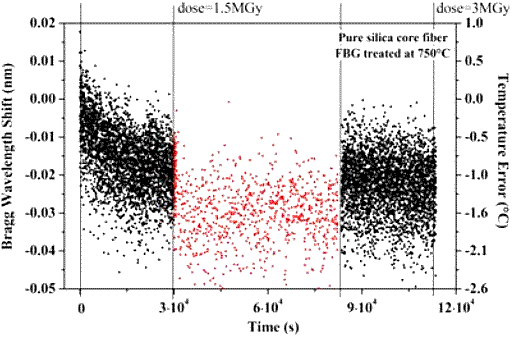Overview
As a result of the femtosecond manufacturing process Fibos utilizes, photosensitivity is no longer a requirement of the fiber we wish to write an FBG into. With the femtosecond process, we can write a grating into pure silica fiber, also known as Rad Hard fiber. An example of this fiber type can be found from Nufern, an optical fiber producer. This fiber has a pure silica core, unlike most standard telecommunications fibers that have germanium doped into the glass. FBGs cannot be produced in this fiber by the UV inscription technique.
There is evidence from testing conducted by Fibos and by other researchers that show FBGs produced by the femtosecond phase mask approach in pure silica fibers are not susceptible to high dosages of radiation. Testing conducted by Fibos was done at TRIUMF, a Canadian research particle accelerator that can produce high radiation dosage. These dosages are still lower than the dosages that would be seen in a nuclear facility. A report of the testing conducted at TRIUMF can be requested from the Fibos team. As a brief summary, the radiation dosages experienced by the optical sensors during this testing can be seen in the graph below and the Total Dose was below 10KGy.

External Research
Research work is limited in the area of radiation sensitivity for FBG sensors due to the testing environment required. Dr. Adriana Morana completed her PhD thesis on FBG performance in high radiation environments and is a good reference for the commercial opportunities Fibos wants to explore. Dr. Morana's full thesis is available publicly: Gamma-rays and neutrons effects on optical fibers and Bragg gratings for temperature sensors.
The research utilized the same femtosecond phase mask approach that Fibos uses; in fact, the gratings in pure silica fiber Dr. Morana used were produced at the National Research Council of Canada. The results were promising and show that even at high temperatures (230C), and high radiation dose (up to 3MGy), over a period of roughly 30hrs, there is no drift experienced by the sensor. As can be seen in the figure below, the measurement doesn't change significantly over the test. The measurement system noise contributes to uncertainty on the amount of drift experienced, but it looks like it would be <1°C if an average was taken from all the data.

Optical Transducers for Nuclear Applications
It is possible for us to replace the sensing element within our optical transducers with a radiation immune FBG sensor. The Fibos team is actively exploring sensor developments for nuclear facilities and research institutes. Please reach out to the Fibos team for additional information for your nuclear application.
X

